This article is an autobiography or has been extensively edited by the subject or by someone connected to the subject.(October 2013) |

Noah Brosch (born 1948) is an Israeli astronomer, astrophysicist and space researcher.
This article is an autobiography or has been extensively edited by the subject or by someone connected to the subject.(October 2013) |

Noah Brosch (born 1948) is an Israeli astronomer, astrophysicist and space researcher.
Noah Brosch was born in Bucharest (Romania) in 1948 and immigrated with his family to Israel in 1963.
Brosch studied at Tel Aviv University (BSc 1975 and MSc 1977) and at the Leiden University (PhD 1983). He is a tenured Principal Research Associate (degree equivalent to Research Associate Professor) at Tel Aviv University and served as Director of the Wise Observatory from 2000 to 2006 and again from 2007 to 2010. He is a member of the International Astronomical Union (IAU) and from 2009 to 2012 served as the Vice-President of its Division XI (Space and High-Energies Astrophysics) of the IAU. [1]
Noah Brosch has been active in the field of space ultraviolet (UV) astronomy, as one of the founding members of the Network for Ultraviolet Astrophysics (NUVA), a pan-European network set-up to identify the needs of the astronomical community in the UV spectral domain and eventually propose actions to structure it around new projects. [2]
Brosch retired from his academic position in May 2017 (age limit for Tel Aviv University academics) but remains an active researcher retaining his office, observing time allocation, etc.
Brosch was the Principal Investigator of the TAUVEX space telescope array from 1989 to 2011. TAUVEX was intended to study the ultraviolet sky in spectral bands not observable from the ground by using three co-aligned telescopes, each imaging the same one-degree wide sky region. Because of these innovative aspects, TAUVEX was selected in 1988 by the Israel Space Agency (ISA) as its first priority experiment to be launched in space, but its promised satellite and launcher never materialized. The TAUVEX project was cancelled by ISA after attempts to launch it as an associated payload on the Spektr-RG platform (led by the Soviet Union) between 1991 and 2000, then later from 2000 to 2010 on the Indian GSAT-4 spacecraft, failed for various reasons. ISA also refused to let the fight model of TAUVEX be used for balloon flights that could have yielded valuable information in a spectral band around 200 nm.
Brosch and Adi Zitrin, his MSc student, identified a possible dark matter filament relatively close to the Milky Way and the Local Group in the form of a chain of galaxies in the local void . [3] The reality of this galaxy filament, and the identification of another, shorter filament in the same neighborhood, was confirmed by McQuinn et al. (2014). [4] Together with another student, he showed that many near-Earth asteroids are probably only "rubble piles" so that attempts to mitigate possible future impacts by such asteroids using exploding nuclear devices might not be successful. [5]
Noah Brosch organized a campaign to observe the Leonid meteor shower in 1999 that included ground teams in Israel equipped with intensified video cameras and airborne observations from two NASA aircraft that deployed to Ben Gurion airport in Israel in order to observe meteors from a high altitude together with the ground teams and with a powerful phased-array radar in Israel. A description of the campaign and some of the results were published in the book "Leonid Storm Research" . [6]
Noah Brosch was fascinated very early in his scientific career by the unique appearance of Hoag's Object, a very round ring galaxy and published a number of papers on this topic. Together with his student Ido Finkelman, and with colleagues from Russia and the Netherlands, they showed that the visible ring is part of an even larger ring of neutral hydrogen and proposed that the ring represents material accreted by the elliptical core at least one billion years ago. Hoag's Object would, therefore, represent a much undisturbed galaxy . [7]
Brosch and colleagues, and other students, investigated the properties of extragalactic dust by concentrating on elliptical galaxies with dark lanes. Modeling the light distribution of the unaffected parts of a galaxy, and subtracting from it the detected light distribution, they derived the amount of light missing because of the dust obscuration. Repeating this with different filters, they found that it is possible to derive the extinction law by the dust in the target galaxy which measures essentially the typical size of dust grains. Since this size is of order 0.1 micron while the typical distance to the galaxies studied is of order 50 Mpc, the ratio of sizes is 31 orders of magnitude.
Noah Brosch and his students investigate various aspects of star formation in galaxies. Important contributions were made in the field of dwarf galaxies, as well as on the influence of the environment in the formation and evolution of galaxies.
Brosch discovered the atmosphere of Pluto in 1985 by observing the occultation of a star by the then-considered outermost planet in the Solar System. [8] This observation was analyzed in a paper published much later. [9]
Minor planet 26282 Noahbrosch is named in his honor. [10]
Brosch is an author of many scientific papers and of outreach publications. He published alone or with colleagues a number of books. One of his semi-popular books is Sirius Matters , [11] a scientific monograph about the star Sirius.

Sirius is the brightest star in the night sky. Its name is derived from the Greek word Σείριος, meaning lit. 'glowing' or 'scorching'. The star is designated α Canis Majoris, Latinized to Alpha Canis Majoris, and abbreviated α CMa or Alpha CMa. With a visual apparent magnitude of −1.46, Sirius is almost twice as bright as Canopus, the next brightest star. Sirius is a binary star consisting of a main-sequence star of spectral type A0 or A1, termed Sirius A, and a faint white dwarf companion of spectral type DA2, termed Sirius B. The distance between the two varies between 8.2 and 31.5 astronomical units as they orbit every 50 years.

Astronomy is a natural science that studies celestial objects and the phenomena that occur in the cosmos. It uses mathematics, physics, and chemistry in order to explain their origin and their overall evolution. Objects of interest include planets, moons, stars, nebulae, galaxies, meteoroids, asteroids, and comets. Relevant phenomena include supernova explosions, gamma ray bursts, quasars, blazars, pulsars, and cosmic microwave background radiation. More generally, astronomy studies everything that originates beyond Earth's atmosphere. Cosmology is a branch of astronomy that studies the universe as a whole.

Hoag's Object is an unusual ring galaxy in the constellation of Serpens Caput. It is named after Arthur Hoag, who discovered it in 1950 and identified it as either a planetary nebula or a peculiar galaxy. The galaxy has a D25 isophotal diameter of 45.41 kiloparsecs (148,000 light-years).
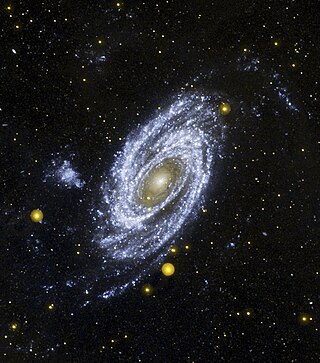
Ultraviolet astronomy is the observation of electromagnetic radiation at ultraviolet wavelengths between approximately 10 and 320 nanometres; shorter wavelengths—higher energy photons—are studied by X-ray astronomy and gamma-ray astronomy. Ultraviolet light is not visible to the human eye. Most of the light at these wavelengths is absorbed by the Earth's atmosphere, so observations at these wavelengths must be performed from the upper atmosphere or from space.

An astronomical object, celestial object, stellar object or heavenly body is a naturally occurring physical entity, association, or structure that exists within the observable universe. In astronomy, the terms object and body are often used interchangeably. However, an astronomical body or celestial body is a single, tightly bound, contiguous entity, while an astronomical or celestial object is a complex, less cohesively bound structure, which may consist of multiple bodies or even other objects with substructures.

Observational astronomy is a division of astronomy that is concerned with recording data about the observable universe, in contrast with theoretical astronomy, which is mainly concerned with calculating the measurable implications of physical models. It is the practice and study of observing celestial objects with the use of telescopes and other astronomical instruments.
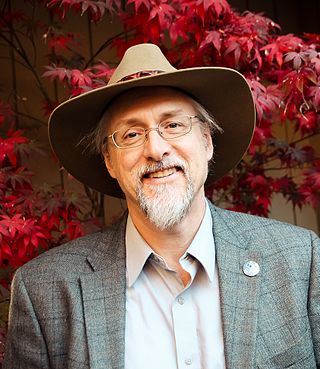
Marc William Buie is an American astronomer and prolific discoverer of minor planets who works at the Southwest Research Institute in Boulder, Colorado in the Space Science Department. Formerly he worked at the Lowell Observatory in Flagstaff, Arizona, and was the Sentinel Space Telescope Mission Scientist for the B612 Foundation, which is dedicated to protecting Earth from asteroid impact events.
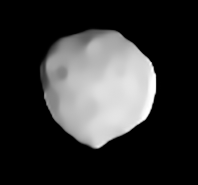
Bamberga is one of the largest asteroids in the asteroid belt. It was discovered by Johann Palisa on 25 February 1892 in Vienna. It is one of the top-20 largest asteroids in the asteroid belt. Apart from the near-Earth asteroid Eros, it was the last asteroid which is ever easily visible with binoculars to be discovered.
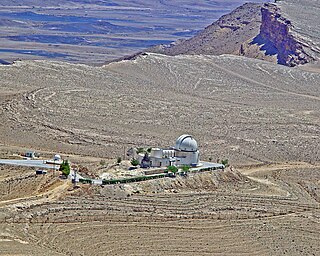
The Florence and George Wise Observatory is an astronomical observatory owned and operated by Tel Aviv University. It is located 5 kilometers west of the town of Mitzpe Ramon in the Negev desert near the edge of the Ramon Crater, and it is the only professional astronomical observatory in Israel.

The following outline is provided as an overview of and topical guide to astronomy:
The Tel Aviv University Ultraviolet Explorer, or TAUVEX, is a space telescope array conceived by Noah Brosch of Tel Aviv University and designed and constructed in Israel for Tel Aviv University by El-Op, Electro-Optical Industries, Ltd. acting as Prime Contractor, for the exploration of the ultraviolet (UV) sky. TAUVEX was selected in 1988 by the Israel Space Agency (ISA) as its first priority scientific payload. Although originally slated to fly on a national Israeli satellite of the Ofeq series, TAUVEX was shifted in 1991 to fly as part of a Spektr-RG international observatory, a collaboration of many countries with the Soviet Union leading.
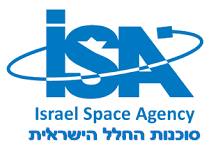
The Israel Space Agency is a governmental body, a part of Israel's Ministry of Science and Technology, that coordinates all Israeli space research programs with scientific and commercial goals.

In cosmology, galaxy filaments are the largest known structures in the universe, consisting of walls of galactic superclusters. These massive, thread-like formations can commonly reach 50/h to 80/h Megaparsecs —with the largest found to date being the Hercules-Corona Borealis Great Wall at around 3 gigaparsecs (9.8 Gly) in length—and form the boundaries between voids. Due to the accelerating expansion of the universe, the individual clusters of gravitationally bound galaxies that make up galaxy filaments are moving away from each other at an accelerated rate; in the far future they will dissolve.
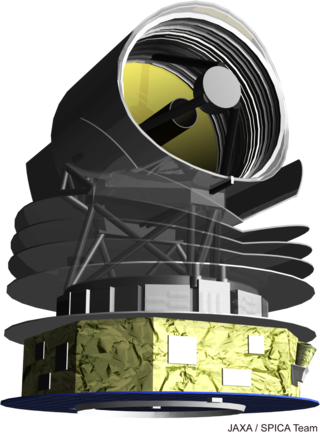
The Space Infrared Telescope for Cosmology and Astrophysics (SPICA), was a proposed infrared space telescope, follow-on to the successful Akari space observatory. It was a collaboration between European and Japanese scientists, which was selected in May 2018 by the European Space Agency (ESA) as a finalist for the next Medium class Mission 5 (M5) of the Cosmic Vision programme, to launch in 2032. At the time the other two finalists were THESEUS and EnVision, with the latter that was eventually selected for further development. SPICA would have improved on the spectral line sensitivity of previous missions, the Spitzer and Herschel space telescopes, between 30 and 230 μm by a factor of 50—100.
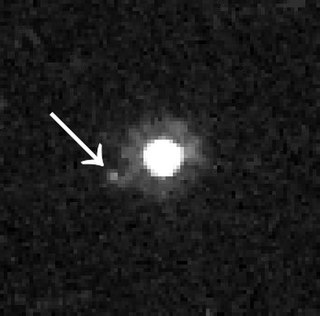
Weywot is a natural satellite or moon of the trans-Neptunian dwarf planet Quaoar. It was discovered by Michael Brown and Terry-Ann Suer using images taken by the Hubble Space Telescope on 14 February 2006. Named after the Tongva sky god and son of Quaoar, Weywot is thought to be a fragment of Quaoar that was ejected into an eccentric orbit around the dwarf planet by a major impact event billions of years ago. The moon is nearly 200 km (120 mi) in diameter and it orbits Quaoar every 12.4 days at an average distance of 13,300 km (8,300 mi). Weywot is thought to play a role in maintaining Quaoar's outer ring by gravitationally influencing it in an orbital resonance.

ULTRASAT is a space telescope in a smallsat format with a large field of view, 210 square degrees, that will detect and monitor transient astronomical events in the near-ultraviolet (220–280 nm) spectral region. ULTRASAT will observe a large patch of sky, alternating every six months between the southern and northern hemisphere. The satellite will be launched into geosynchronous orbit in early 2026. All ULTRASAT data will be transmitted to the ground in real time. Upon detection of a transient event, ULTRASAT will provide alerts within 20 minutes to other ground-based and space telescopes to be directed to the source for further observation of the event in other wavelength bands.
Lunar Ultraviolet Cosmic Imager (LUCI) is a small planned telescope that will be landed on the Moon to scan the sky in near UV wavelengths. It is a technology demonstrator developed by the Indian Institute of Astrophysics, and it was planned to be one of several small payloads to be deployed by the commercial Z-01 lander developed by TeamIndus in partnership with OrbitBeyond. The mission was planned to be launched in 2020 as part of NASA's Commercial Lunar Payload Services (CLPS). On 29 July 2019 OrbitBeyond announced that it would drop out of the CLPS contract with NASA, meaning that the 2020 launch was canceled and it is unknown whether the mission will ever take place.

Denis Burgarella is a French astrophysicist at Laboratoire d'astrophysique de Marseille.

NGC 5363 is a lenticular galaxy located in the constellation Virgo. It is located at a distance of circa 65 million light years from Earth, which, given its apparent dimensions, means that NGC 5363 is about 100,000 light years across. It was discovered by William Herschel on January 19, 1784. It is a member of the NGC 5364 Group of galaxies, itself one of the Virgo III Groups strung out to the east of the Virgo Supercluster of galaxies.